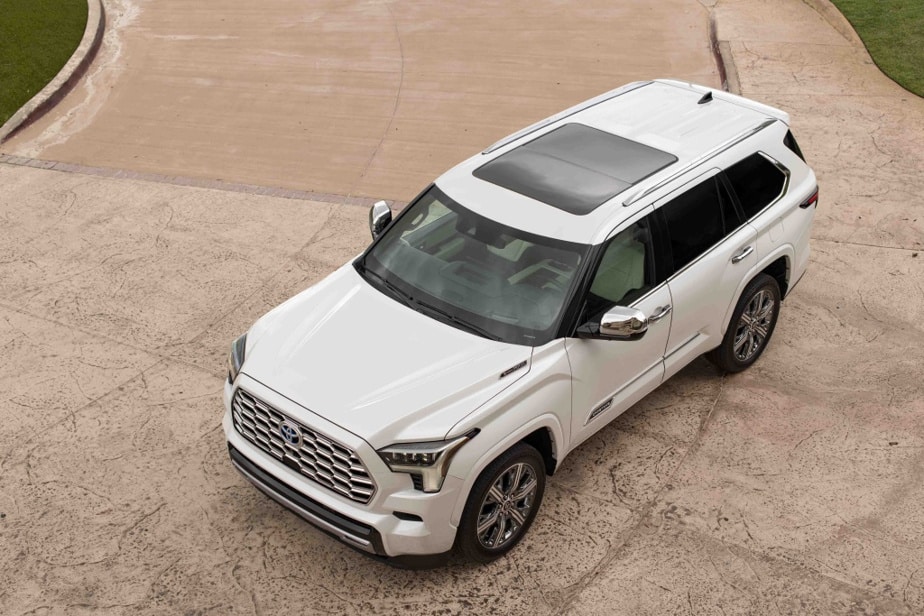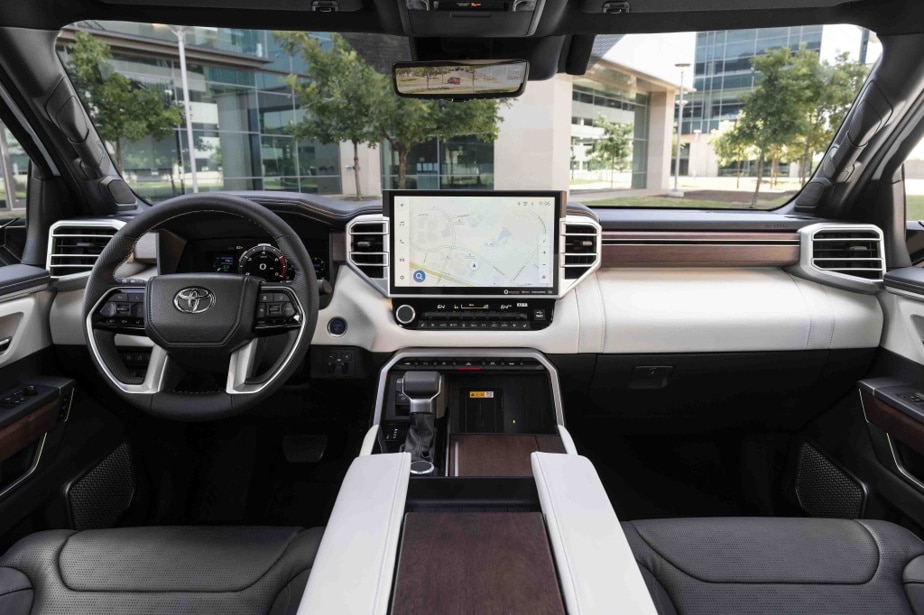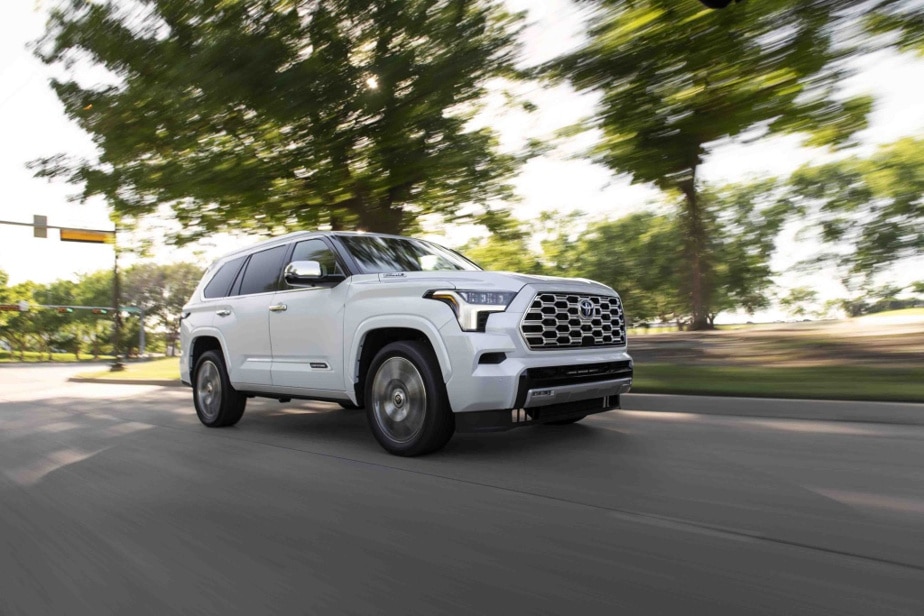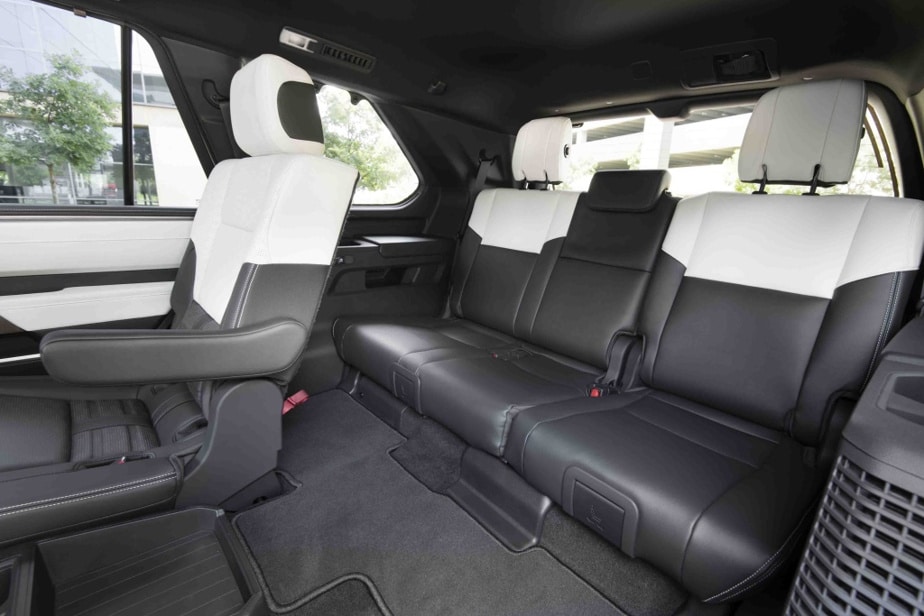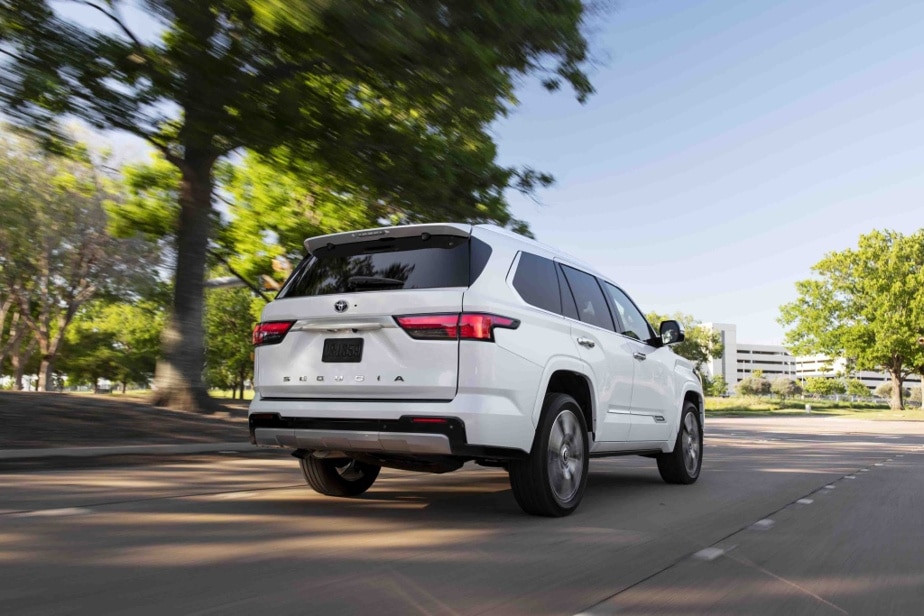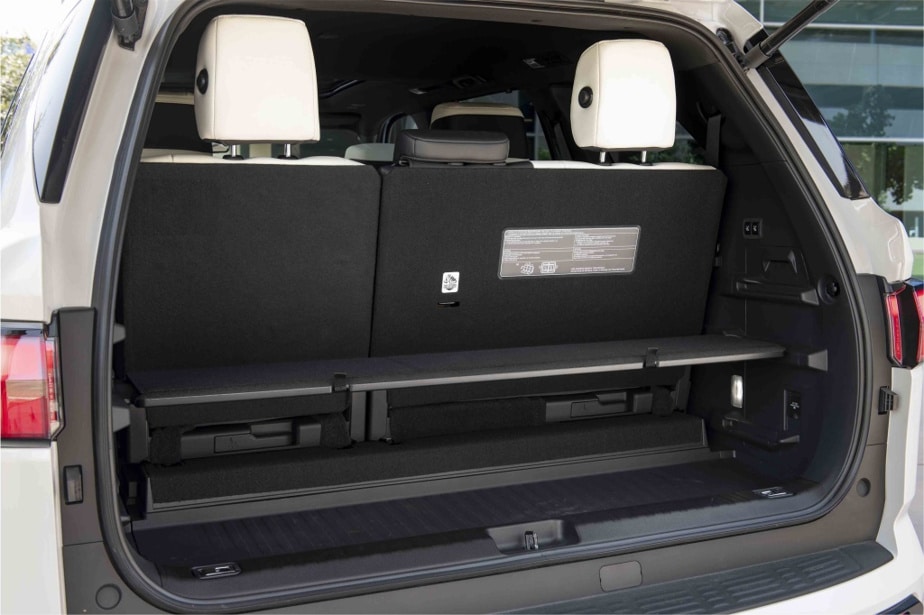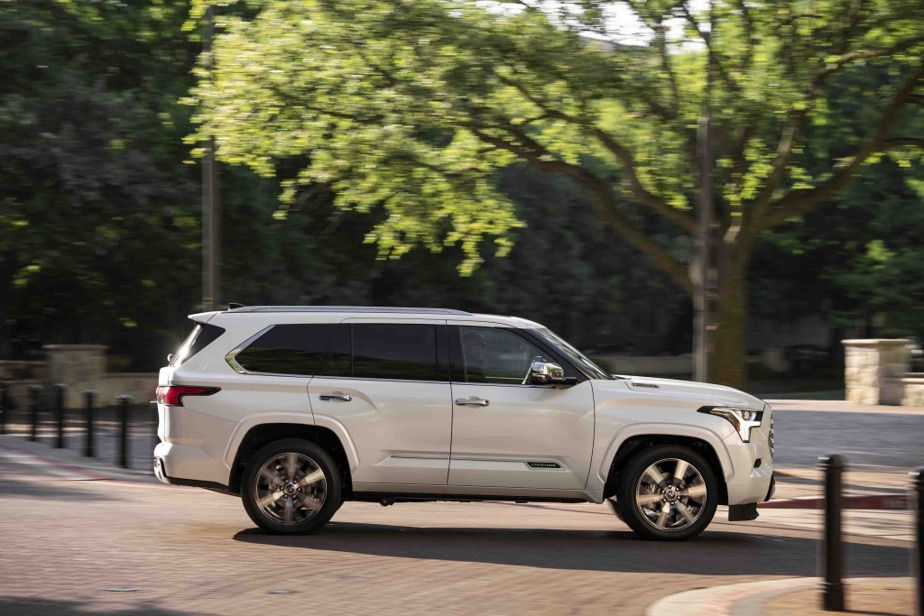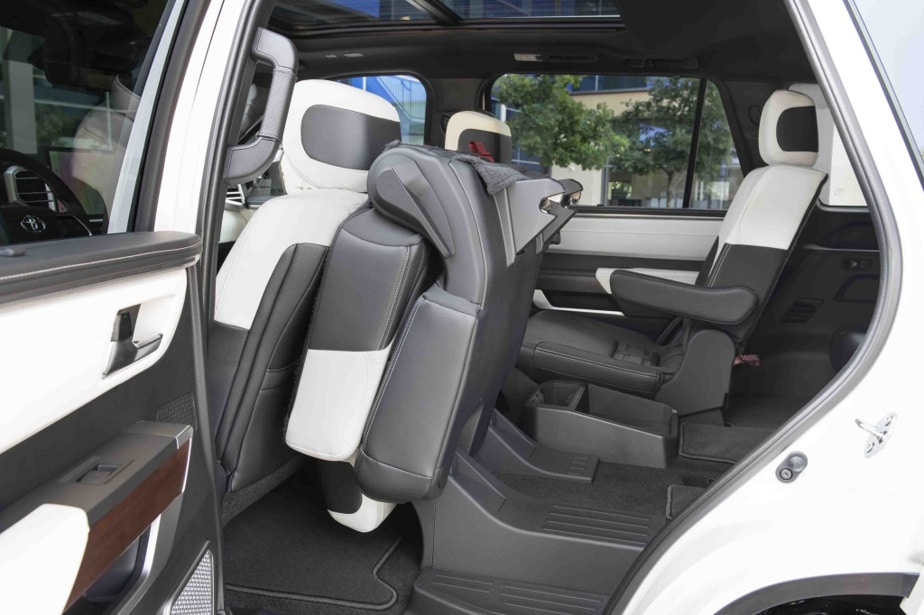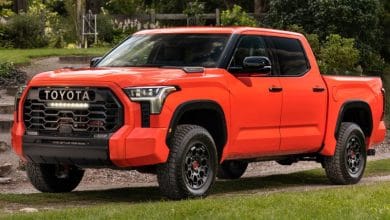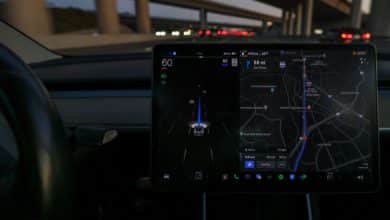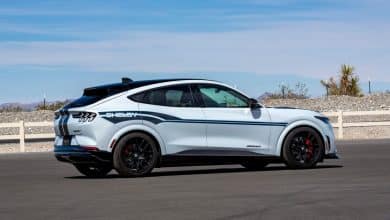It is an event. Toyota is (finally) reworking the Sequoia.
Contents
Better, but still
Fifteen years after its release, the Sequoia passes the baton. Such a long interval can only (well) serve the model that succeeds it today. The new tows heavier loads and consumes less hydrocarbons. Gains that hide some compromises.
The dinosaur that was the Sequoia has died out. His replacement will have (virtually) no trouble burying him. Apart from its more attractive presentation, the latest addition claims to be capable of towing a much heavier load. Music to the ears of the targeted clientele. And even better, this third generation of this Toyota XXL promises to consume with more moderation. Moreover, gasoline now bathes in a smaller tank.
-
PHOTO PROVIDED BY TOYOTA
The ample body of the Sequoia is based on the technical architecture of a full-size pickup truck.
-
PHOTO PROVIDED BY TOYOTA
The large infotainment screen offers relatively pleasant navigation, but its operation appeared unpredictable.
-
PHOTO PROVIDED BY TOYOTA
The Toyota Sequoia manages to reduce its average fuel consumption by some 5 L/100 km and is now the most frugal in its class.
-
PHOTO PROVIDED BY TOYOTA
The third row, not very comfortable, has the merit of being easily accessible and of offering sliding seats.
-
PHOTO PROVIDED BY TOYOTA
Apart from the wind, which occasionally whistles the large mirrors, the acoustic comfort of the cabin is impeccable.
-
PHOTO PROVIDED BY TOYOTA
The trunk offers less space and it is impossible to obtain a perfectly flat floor without using a promontory.
-
PHOTO PROVIDED BY TOYOTA
The Toyota Sequoia combines a hybrid (non-rechargeable) engine with a 10-speed automatic transmission.
-
PHOTO PROVIDED BY TOYOTA
Toyota Sequoia console detail
-
PHOTO PROVIDED BY TOYOTA
The second row of seats tilts to make the third row more accessible.
1/9
These gains will seem spectacular: they are not really. It is more accurate to see this as an evolution that took a long time to materialize. Indeed, since its last redesign (2007), the Sequoia has remained faithful to a V8 engine mated to a six-speed automatic transmission… An inseparable duo bolted to a heavy ladder chassis. A combination largely responsible for the shocking consumption (nearly 17 L/100 km) of this utility. Therefore, today, with the technologies available to it, Toyota could not do worse.
Well-known underwear
No blank page here. Like its competitors, the ample body of the Sequoia is based on the technical architecture of a full-size pickup truck. So this utility derives quite closely from the Tundra, a model that underwent a complete overhaul a short time ago. Like the latter, it combines a hybrid engine (not rechargeable) with a 10-speed automatic transmission. In doing so, this Toyota manages to reduce its average fuel consumption by some 5 L/100 km and is now the most frugal in its class.
This engine, which pairs a 3.4 L (3445 cc) turbocharged six-cylinder with a 36 kW electric power unit, totally eclipses the V8 that once housed this antechamber. And that’s not all. It should also be remembered that the Sequoia now manages to tow an additional load (2000 lb or 907 kg). This suddenly raises the Sequoia to the rank of the strongest (see the “Competition” screen) in its category. In this regard, since the test vehicle does not have a towing package, it was not possible to verify whether this twin-headed engine consumed more fuel than a conventional V8. This was the case of the Tundra hybrid tested last summer.
The Sequoia is a behemoth and it moves like one on the road. Its weight is still felt. Opulent, the Sequoia hates being jostled and finds it difficult to negotiate the rough coatings that make its rear axle stumble.
Let’s recognize that, for some owners, the inertia they will experience at its controls will give them a feeling of well-being rather than frustration. The Sequoia therefore prefers flexibility at the wheel and requires a good dose of anticipation when braking. The latter is not particularly strong or enduring.
The lightness of its steering does not make it more manageable or more agile. Even for a moment, she can’t forget the measurements of this vehicle that you can’t park anywhere and anyhow.
The quiet road
It is only when long – and straight – ribbons of asphalt loom on the horizon that the Sequoia becomes frequentable, peaceful and reassuring. Apart from the wind, which occasionally whistles the large mirrors, the acoustic comfort of the cabin is impeccable. It also features new fittings, notably in its Capstone livery, with light woodwork and two-tone seats. Storage abounds, touch controls are easy to locate and manipulate. Active safety is enriched with cameras, alerts and driving aids. The large infotainment screen offers relatively pleasant navigation, but its operation appeared unpredictable. More than once, the system restarted itself.
When it comes to versatility, however, the Sequoia backtracks. The window no longer slips away between the sides of the tailgate and the trunk is more cramped than that of the previous generation due to a technical choice. Indeed, this Toyota adopts a brand new rear suspension that is more cumbersome than in the past. Consequently, the trunk offers less space and it is impossible to obtain a perfectly flat floor without making use of a promontory. On the other hand, the third row, not very comfortable, has the merit of being easily accessible and of offering sliding seats. Rather thin arguments if we consider the “family” nature of this truck.
Toyota Sequoia
Price range
From $79,334 to $95,334
Visible in dealerships
NOW
Consumption
12.6 L/100 km (winter conditions)
WE love
- More reasonable consumption
- Increased towing capacity
- Significantly improved active safety
We love less
- Trunk smaller than before
- Clumsy behavior
- Footprint
Our Verdict
A necessarily successful redesign, but insufficiently refined to take the lead.
Technical sheet
Engine
- 3.4L V6 DOHC Turbo Hybrid
- 485 hp at 6200 rpm
- 583 lb-ft of torque at 2400 rpm
Performance
- Empty weight: 2805 kg
- Ground clearance: 218mm (231mm – TRD Pro)
- Maximum towing capacity: 4137 kg (SR5 4×4)
Gearbox
- Standard: 10-speed automatic
- Optional: none
- Drive Mode: 4×4
Tires
- 285/60R18 (TRD)
- 265/70R18 (SR5, Limited)
- 265/60R20 (SR5, Limited, Platinum)
- 265/50R22 (Capstone)
Tank capacity and recommended gasoline
Dimensions
- Wheelbase: 3100mm
- Length: 5283 mm/height: 1892 mm (Capstone version)
- Width: 2011 mm (including exterior mirrors)
Moderate your transport

PHOTO PROVIDED BY TOYOTA
Toyota Grand Highlander
If a towing capacity of 5000 lbs is enough, why not consider the Grand Highlander unveiled at the Chicago Auto Show a few days ago? This addition to Toyota’s lineup promises not only to accommodate seven occupants, but also to offer a third seat that’s comfortable enough for adults. As a bonus, the cargo volume of the Grand Highlander surpasses that of the Sequoia. And the icing on the cake: the Grand Highlander features four-cylinder engines, which are more economical at the pump. Did you really need more?
Sewn with gold thread

PHOTO PROVIDED BY LEXUS
Lexus LX600
Lexus’ LX600 shares the same architecture as the Sequoia, but the similarities end there. The Lexus does not offer hybrid mechanics and cannot tow more than 6000 lb (2722 kg). On the other hand, its presentation is more refined, more elegant. The warranty is more generous (4 years/80,000 km) and ride comfort is superior. So did the asking price ($112,932).
The Press will soon publish the test of the following vehicles: BMW i7, Buick Encore GX, Nissan Ariya, Subaru Solterra and Toyota Prius Prime. If you own one of these vehicles or are considering purchasing one, we would love to hear from you.

